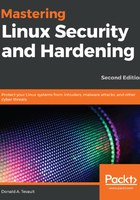
上QQ阅读APP看书,第一时间看更新
Installing a virtual machine in VirtualBox
For those of you who've never used VirtualBox, here's a quick guide to get you going:
- Download and install VirtualBox and the VirtualBox Extension Pack. You can get them from https://www.virtualbox.org/.
- Download the installation .iso files for Ubuntu Server 18.04, CentOS 7, and CentOS 8. You can get them from https://ubuntu.com/download/alternative-downloads#alternate-ubuntu-server-installer and https://www.centos.org/. (Note that for Ubuntu 18.04, you'll need to use this alternate installer. The default installer that you get from the main Download page lacks some of the features that you'll need to complete the exercises.)
- Start VirtualBox and click the New icon at the top of the screen. Fill out the information where requested. Increase the virtual drive size to 20 GB, but leave everything else as the default settings, as shown in the following screenshot:

- Start the new virtual machine. Click on the folder icon at the bottom-left corner of the dialog box and navigate to the directory where you stored the .iso files that you downloaded. Choose either the Ubuntu ISO file or the CentOS ISO file, as shown in the following screenshot:

- Click the Start button on the dialog box to start installing the operating system. Note that, for Ubuntu Server, you won't be installing a desktop interface. For the CentOS 7 virtual machine, choose either the KDE desktop or the GNOME desktop, as you desire. For CentOS 8, your only desktop choice is GNOME. (We'll go through at least one exercise that will require a desktop interface for the CentOS machine.)
- When installing Ubuntu, choose Install Ubuntu Server when you get to the following screen:

- Repeat the procedure for the other Linux distributions.
- Update the Ubuntu virtual machine by entering the following commands:
sudo apt update
sudo apt dist-upgrade
- Hold off on updating the CentOS virtual machine because we'll do that in the next exercise.
- For Ubuntu, choose No automatic updates on the Configuring tasks screen, and choose to install the OpenSSH Server on the Software selection screen.
When installing Ubuntu, you'll be asked to create a normal user account and password for yourself. It won't ask you to create a root user password, but will instead automatically add you to the sudo group so that you'll have admin privileges.
When you get to the user account creation screen of the CentOS installer, be sure to check the Make this user administrator box for your own user account, since it isn't checked by default. It will offer you the chance to create a password for the root user, but that's entirely optional—in fact, I never do.
When you get to the user account creation screen of the CentOS installer, be sure to check the Make this user administrator box for your own user account, since it isn't checked by default. It will offer you the chance to create a password for the root user, but that's entirely optional—in fact, I never do.
The user account creation screen of the RHEL 8 installer—which looks the same as the one on CentOS 7 and CentOS 8—is shown here:

For Ubuntu 18.04, you'll go through several self-explanatory screens to set up your real name, a username, and a password. The Ubuntu installer will automatically add your user account to the sudo group, which will give you full administrator privileges.
Here's the user account creation screen for Ubuntu 18.04:

So, now, let's change gears and move on to CentOS 7.